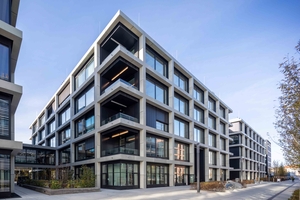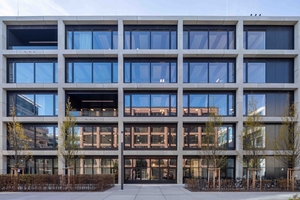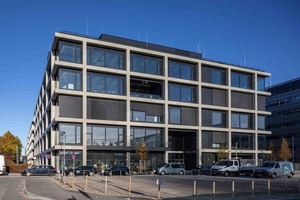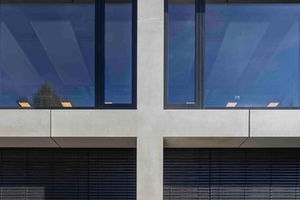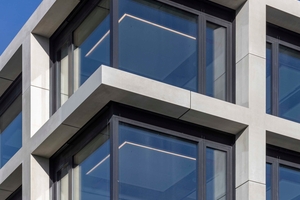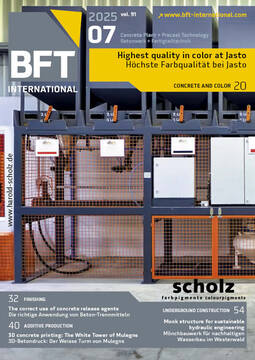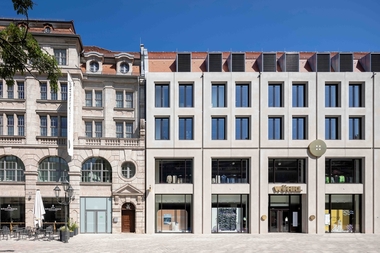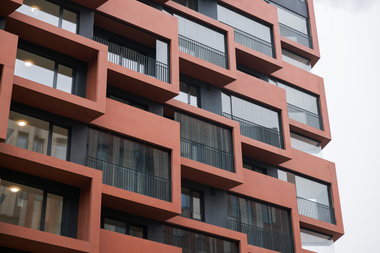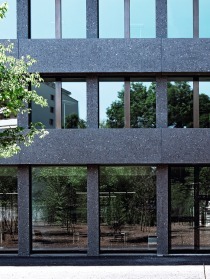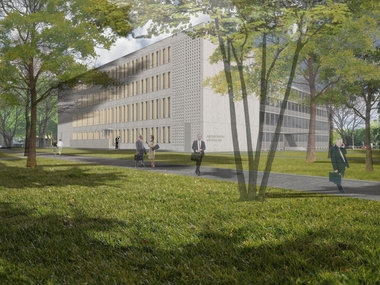Groundbreaking office building: Munich
iCampus project features gray architectural concrete façade
Located in Munich’s Werksviertel district, a former industrial and commercial site, the three iCampus buildings introduce a new office typology to the neighborhood. The façades of the Alpha, Beta and Gamma buildings feature a deep grid consisting of load-bearing architectural concrete elements appearing in a light gray shade.
Project stakeholders
Developed by R&S Immobilienmanagement GmbH, the real estate subsidiary of electronics group Rohde & Schwarz, iCampus is a new office ensemble situated in Munich’s Werksviertel neighborhood. Three of its buildings were designed by KAAN Architecten (façades, bridges and atrium roofs) and RKW Architektur + (structure and floor plans). Hemmerlein Ingenieurbau GmbH was commissioned with designing, producing, delivering and assembling the gray architectural concrete elements. Named the “House of Communication” by its users, the complex is now home to one of Germany’s largest communication agencies, Serviceplan.
Grid structure made of architectural concrete
The architectural concrete grid articulates the façades, while dark metal cladding wraps the entrances as well as building service and other closed areas like a continuous skin. Consisting of large precast elements, the grid-like façade features generously dimensioned openings that are easily adaptable to the varying typologies and sizes of future-proof office layouts. To transcend the conventional office aesthetic and create a sense of openness, the division of larger elements into smaller components and the number of vertical profiles were limited.
800 large precast elements
The façade consists of over 800 large precast elements distributed across the three buildings. Their size implies fewer structural joints and thus shorter assembly times, making them both cost- and time-efficient. This is in line with Hemmerlein’s corporate philosophy of designing high-quality, durable, and aesthetically pleasing façades while using concrete as sustainably as possible – from ensuring material efficiency in design and construction to using low-carbon cements and recycled materials.
Several spacious loggias are incorporated into the façades and equipped to become workspaces, weather permitting. On the first floor, two continuous bridges provide a structural link between the three buildings, creating a central walkway called “iTrack.” Spanning eleven meters, the bridges can also host small meetings and facilitate exchange between the individual departments.
All floors are grouped around large central atria that represent the social core of the complex. The atria are crowned with elegant ceiling structures made of laminated timber beams that provide plenty of daylight while preventing overheating. The design also includes green roof terraces that are accessible to all tenants and provide views of the Alps. Rooted in the rational appearance of the site’s industrial heritage, with generously dimensioned openings and a high level of refinement, the iCampus complex blends with the existing urban fabric and creates a comfortable, future-proof work environment.
Strong architectural identity
Located on a former industrial and commercial site near the Ostbahnhof train station, the Werksviertel area combines a variety of architectural styles, challenging the iCampus project to establish its own strong architectural identity while integrating smoothly into the existing context. The façade designed by KAAN Architecten consolidates the design principles of the district and lends an iconic identity to the new buildings.
iCampus exudes transparency through loft-like spaces that establish a novel office typology in the region. Only five instead of the approved six floors were built, allowing for a greater floor-to-ceiling height of up to four meters that enhances the aspect of openness and creates an attractive work environment. All floors are arranged around large central atria that provide plenty of daylight despite the buildings’ depth. With over 25 meters in height, the atria represent the social core of the complex – a central place to meet that expands towards the entrance to establish a link to the public space outside.
The atria are crowned with elegant ceiling structures whose simple two by two meter grid replicates the façade aesthetic. Their horizontal framework is made of laminated timber beams fitted with acoustic elements, sunscreens, and lights. The roofs should maximize the entrance of sunlight while their smart design also prevents overheating. Green outdoor terraces are accessible to all tenants and provide views of the Alps. Overall, the roof is treated as the fifth façade, going beyond its function as a purely technical space and thus making it an integral part of the buildings.
Through spacious loggias, roof terraces with mountain views and flexible workspaces, the iCampus buildings create a comfortable, future-proof work environment. Rooted in the rational appearance of the site’s industrial heritage, with generously dimensioned openings and a high level of refinement, the overall design blends with the existing urban fabric and adds a new contemporary layer dedicated to the creative industry.
CONTACT
Hemmerlein Ingenieurbau GmbH
Industriestraße 2
92439 Bodenwöhr/Germany
+49 9434 9406 0

